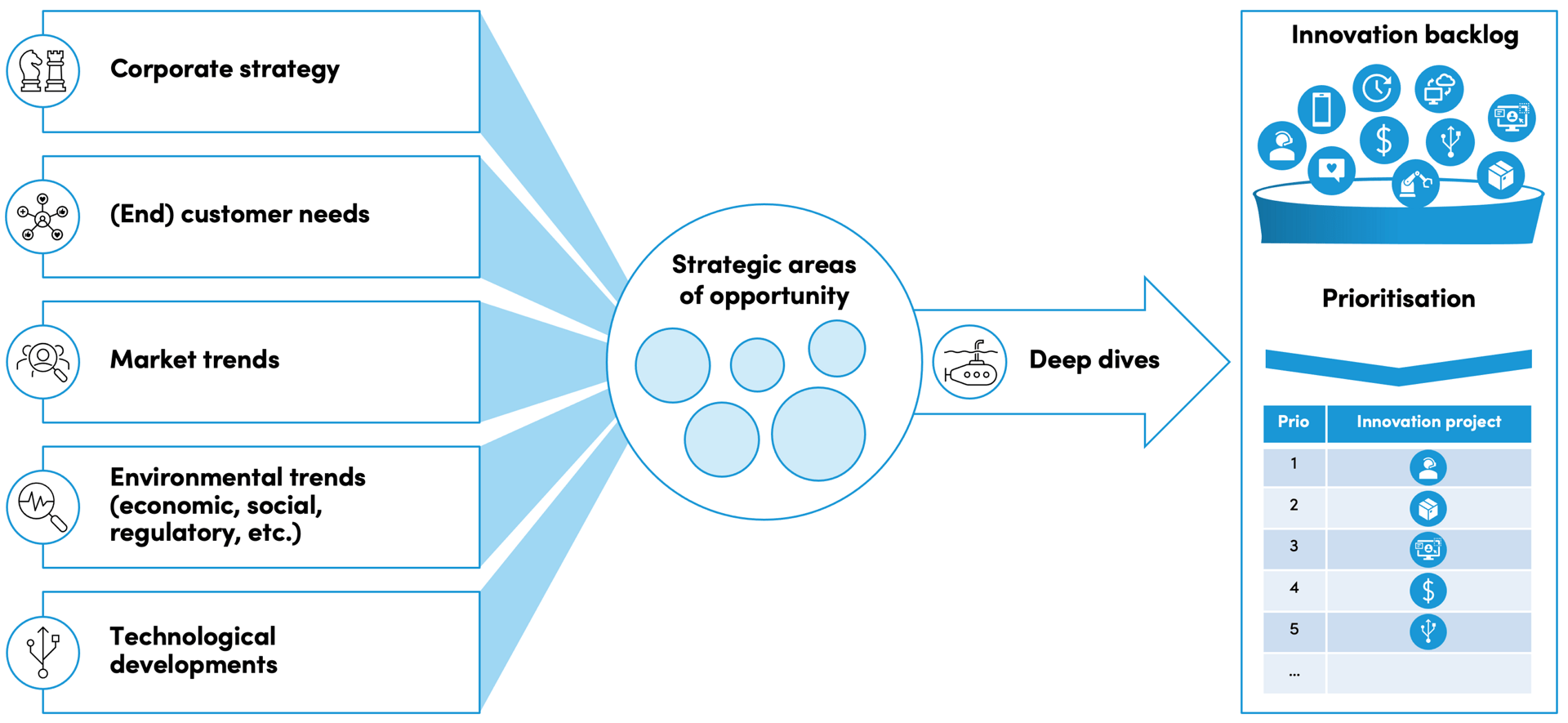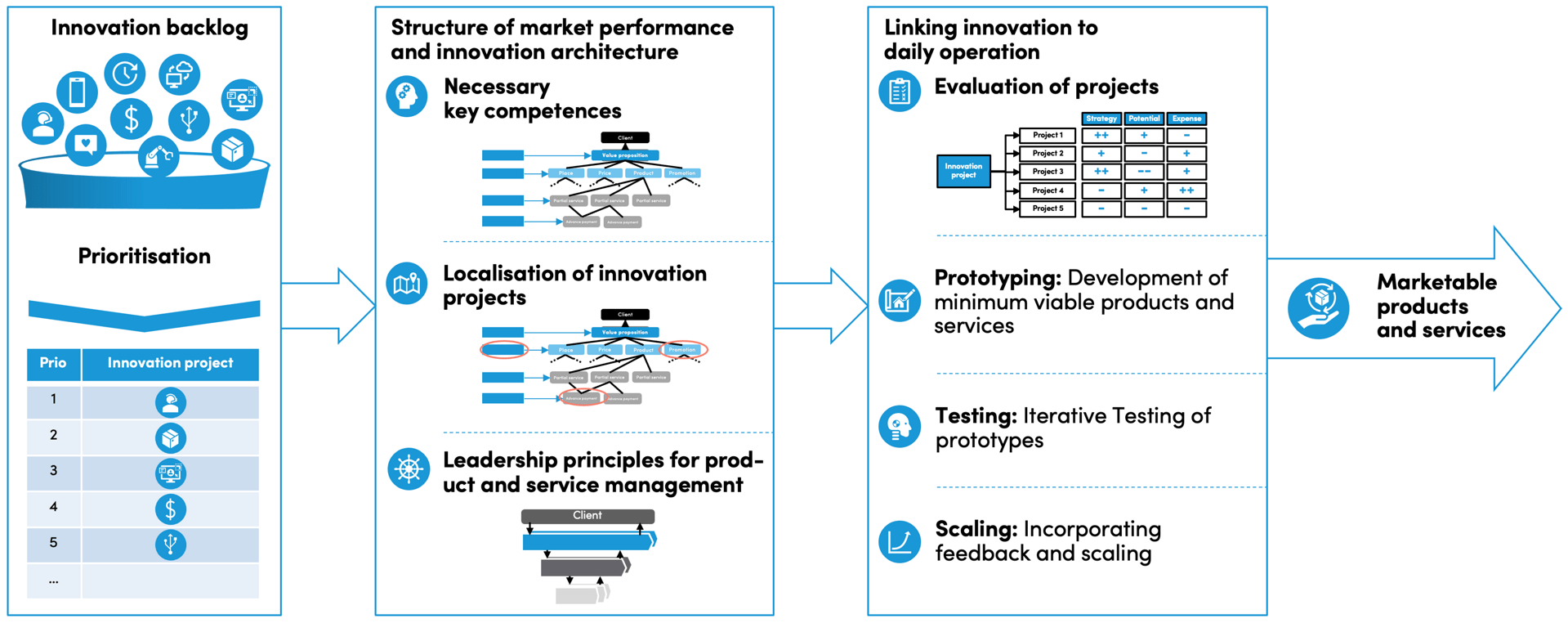hpo Spotlight Innovation
Innovation as a success factor - successfully designing products and services
In a competitive environment, customers are won by those who continuously develop themselves and their market services – based on market and customer needs. Geopolitical changes, economic uncertainties, and rapid technological progress are challenging in innovation. In this dynamic environment, it is crucial to act strategically, efficiently, and pragmatically in order to be successful on the long run.
Share article

The pressure to innovate – and how to tackle it
Companies often struggle with rising development costs without realising the hoped-for added value. If there is no strategic focus, resources are wasted. Cuts in development budgets, a lack of alignment with the corporate strategy, and the pressure to react to market changes exacerbate the situation.
A structured and strategically orientated approach is required to overcome those challenges and exploit the innovation potential within the company with innovative products and services.
Identify and utilise strategic areas of opportunity
The first step is to identify the right strategic areas of opportunity and utilise them in a targeted manner. The strategic areas of opportunity are influenced by five key factors:

Corporate strategy:
It sets the direction and helps to prioritise opportunities. With a clear strategy, resources can be deployed in a targeted manner, and innovations can be driven forward.
(End) customer needs:
They decide which products and services are successful. Regular feedback and adaptation to changing preferences are the key to remaining relevant.
Market trends
They initiate developments within the company. Those who recognise the current and future needs of the market strengthen their market position in the long term. Innovation for one becomes innovation for many.
Environmental trends (economic, social, regulatory, etc.):
They influence market conditions and the business environment. Those who analyse these trends can minimise risks and exploit opportunities at an early stage.
Technological developments:
They open up new opportunities for innovation and efficiency. Those who continuously monitor and integrate these developments remain competitive.
The systematic identification of areas of opportunity ensures the effectiveness of the innovation early on in the process. This keeps innovation focussed and strategically meaningful. The focus on the most important strategic areas of opportunity is achieved by consolidating a longlist into a shortlist, in which the innovation projects are already prioritised.
Deep dive and derivation of an innovation backlog
After identifying the areas of opportunity, in-depth analyses are required to unleash relevant innovation potential and develop new products and services. These in-depth analyses help to further substantiate innovation potential.
This results in an innovation backlog – a tool that helps companies to manage and prioritise a large number of ideas. Ongoing innovation projects are also taken into account.
Careful prioritisation of innovation projects and existing innovation projects is the next step in moving from innovation backlog to concrete products and services. The prioritisation is based on criteria such as market potential, strategic relevance, technological feasibility, and resource expenditure.
From the innovation backlog to specific products and services
The structure of the market performance and the innovation architecture are developed based on the current value proposition and customer needs. These structures help to specifically locate the innovation projects and identify the necessary skills and key competences for their implementation.
Clear responsibilities for product and service owners are necessary for the targeted implementation of innovation projects. The main task of product owners is to initiate the right programs. Development teams are then responsible for realising projects. This is defined and recorded in leadership principles for product and service management.

To become scalable, innovation must be closely linked to daily operation. Innovation projects are evaluated in competition with other projects based on criteria such as strategic fit, potential and effort. Necessary elements are then developed in a program so that the broadened offering is ready and can be implemented.
As soon as these prerequisites are met, rapid prototyping is used to implement minimum viable products or services. In a user-centred and iterative process, the prototypes are tested on the market to incorporate feedback in further development. This makes it possible to test feasibility and acceptance of the project and minimise risk of developing disconnected from the customer. After successful validation of the innovation projects, focus is set on scaling and implementing the new products and services.
In upscaling, reproducibility and variety play a central role in maximising the effectiveness of innovations: reproducibility makes it possible to efficiently repeat successful approaches. Varieties channel multi-optionality by providing a selection without having to fully customise each product or service.
Added value of the hpo innovation approach
What characterises the hpo innovation approach is deriving products and services from market needs – but especially a fast operationalisation in daily business. The necessary skills and key competences are identified and developed with employees and teams. Areas of expertise are bundled, and resources are allocated to create the right team skills.
A clear structuring of innovation topics and a targeted allocation of necessary resources and capabilities helps to build an effective innovation process. The hpo innovation approach offers the following advantages:
Timing for go-to-market
through reduced time-to-market, acceleration or deceleration
Better cost control
through controlled innovation and operationalisation
Stronger customer orientation
through rapid prototyping and constant exchange with the market
Capable high performance organisation
by mastering state-of-the-art technology and developing skills as a core process of innovation
A well-structured innovation process releases innovation potential for a company and transforms those into successful products and services. A clear focus on customer needs and corporate strategy makes a successful company stand out.
Arrange a free initial consultation now
Volker Schemmann
Associate Partner
